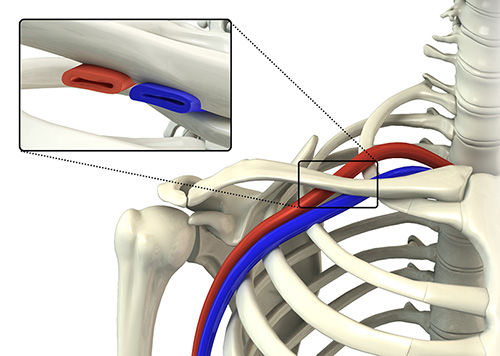Thoracic Outlet Syndrome (TOS): What Massage Therapists Need to Know
- 5 Hours CPD Points Awarded Details Below

- Oct 6, 2023
- 2 min read
Introduction to Thoracic Outlet Syndrome for Massage Therapists
As a dedicated remedial massage therapist, you're no stranger to the intricate interplay between the body's muscles, nerves, and bones. You're keenly aware of the importance of maintaining a holistic, addressing not just the symptoms but the underlying causes of discomfort and pain. In your journey to becoming a proficient therapist, it's crucial to familiarize yourself with various conditions that may affect your clients. One such condition is Thoracic Outlet Syndrome (TOS). In this blog post, we'll explore what TOS is and what massage therapists need to know about it to provide the best care possible.

Understanding Thoracic Outlet Syndrome
Thoracic Outlet Syndrome (TOS) is a complex and often misunderstood condition that can cause a range of symptoms in the upper body. It affects approximately 8% of the population, with a female-to-male ratio of up to 4:1. It occurs when the nerves and blood vessels that travel from the neck through the thoracic outlet (a narrow passageway between the collarbone and the first rib) become compressed or irritated.
Types of TOS
There are three primary types of TOS:
Neurogenic TOS: This is the most common form of TOS, characterized by the compression of the brachial plexus, a network of nerves that controls the arm and hand muscles. Clients with neurogenic TOS may experience pain, weakness, and numbness in the arm and hand.
Vascular TOS: Vascular TOS involves the compression of the subclavian artery or vein, which can lead to circulation problems and potentially serious complications. Symptoms may include arm swelling, discolouration, and coldness.
Nonspecific or Disputed TOS: This category includes cases where the exact cause of symptoms is unclear or disputed. Clients may report various symptoms, and a diagnosis can be challenging.
 If you would like to find out more about thoracic outlet syndrome and CPD points at the same time please check out our professional development course Find Out More |
What Massage Therapists Need to Know
Recognition of Symptoms: Familiarize yourself with the common symptoms of TOS, such as pain, numbness, tingling, and weakness in the arm, hand, or fingers. Clients may also complain of neck and shoulder pain.
Client Assessment: During your initial assessment, be attentive to any signs or symptoms that may indicate TOS. Ask about their medical history, including any previous injuries or conditions.
Referral: If you suspect a client may have TOS, it's essential to refer them to a healthcare professional for a proper diagnosis. TOS can mimic other conditions, so a thorough evaluation by a physician is crucial.
Communication: Maintain open and honest communication with your clients. If a client has been diagnosed with TOS, work closely with their healthcare team to develop a massage therapy plan that complements their treatment.
Gentle Techniques: For clients with TOS, avoid using deep tissue or high-pressure massage techniques in the affected area. Instead, focus on gentle, soothing techniques that promote relaxation and reduce muscle tension.
Postural Awareness: Educate your clients about the importance of maintaining good posture to alleviate TOS-related symptoms. Offer guidance on ergonomic practices and exercises to help them manage their condition.
In conclusion, thoracic outlet syndrome is a condition that may present in your massage therapy practice. By understanding its basics and collaborating with healthcare professionals, you can provide valuable support to clients dealing with TOS.





Comentarios